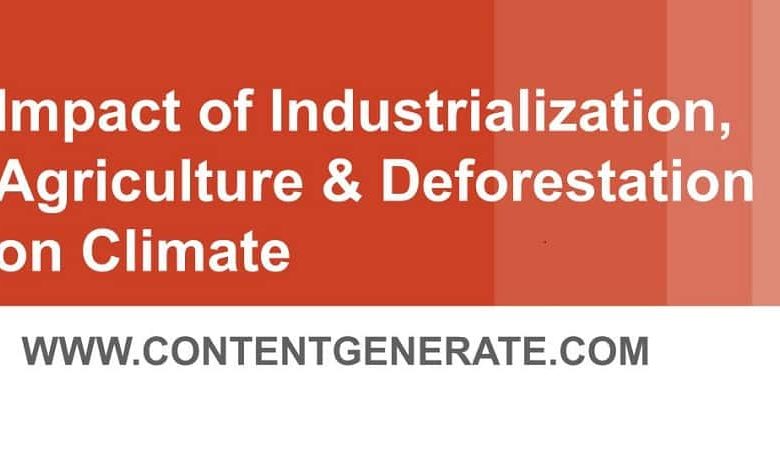Human Activities and Their Impact on Climate

This post discusses the impact of human activities on climate. Major human activities influencing climate include industrialization, agricultural practices, deforestation, etc.
Contents
Human Activities and their impact on Pollution
Industrialization
The term ‘Industrialization’ refers to the establishment of more and more industries in any place.
Industries are the main source of air, land, and water pollution. Toxic and harmful gases emitted into the air cause different diseases both in humans and animals i.e, asthma, respiratory problems, and cancer, etc. These gases also make a layer in the atmosphere. Because of the greenhouse effect of these gases, the problem of global warming is caused. Global warming in turn acts as the main agent of climate change.
Agricultural Practices
Agricultural practices are characterized by the use of technology and machinery i.e. tractors, combined harvesters, thrashers, etc. This machinery and technology consume fossil fuels for operation. The smoke emitted into the air due to the burning of fossil fuels in the machinery also contains gases such as carbon dioxide, sulfur dioxide, etc. which contribute towards global warming and climate change.
Deforestation
The term ‘deforestation’ refers to the uncontrolled cutting down of trees to fulfill different needs of human beings.
Deforestation is another human activity that directly contributes to climate change. As plants absorb carbon dioxide and release oxygen. With uncontrolled cutting down of trees throughout the world, the amount of carbon dioxide in the atmosphere increases. Carbon dioxide also one of the greenhouse gases causing global warming and climate change.
With the decrease in the forested areas, the humidity level decrease causing a decrease in rainfall. With decreased rainfall and humidity level, the climatic conditions of the area also changed.
What are the sources of pollution?
Three main sources of pollution (Industrial emissions, human waste, and arsenic) are discussed in the following lines.
Industrial emissions
Industrial emissions refer to gases emitted by industries into the air. These emissions are responsible for air pollution on a massive scale. These gases contain various substances, including sulfur oxides, nitrogen oxides, ammonium, dust and mercury, and other heavy metals, into the air, water, and earth. They are hazardous substances that negatively affect human health and the environment. They cause numerous diseases such as asthma, bronchitis, and cancer, etc.
While acid rain caused by industrial emissions is responsible for ocean acidification and soil degradation, reducing biodiversity in freshwater ecosystems and damaging the built environment.
Human Waste
Humans pollute a lot and contribute to all types of pollution. Human activities like power generation, industrial waste dumped into rivers, polyethylene waste, artificial methods used in agriculture, cell phones, Wi-Fi, etc. negatively affect the environment.
Arsenic
Arsenic is a poisonous chemical present in the subsoil and in rock. The presence of arsenic in water makes water polluted and unfit for drinking. The water virtually looking pure and clean may have an arsenic presence in it. Therefore, medical personals emphasize laboratory tests of water used by people in rural areas for drinking and cooking purposes.
Contaminated groundwater is the most common cause of arsenic poisoning. Long-term exposure to arsenic in drinking water can cause cancer in the skin, lungs, bladder, and kidney. It can also cause other skin changes such as thickening and pigmentation.




